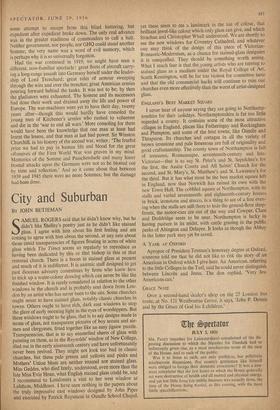City and Suburban
BY JOHN BETJEMAN SAMUEL ROGERS said that he didn't know why, but he didn't like Shelley's poetry just as he didn't like stained glass. 1 agree with him about his first feeling and am coming to agree with him about the second, at any rate about those timid transparencies of figures floating in acres of white glass which The Times seems so regularly to reproduce as having been dedicated by this or that bishop in this or that restored church. There is a boom in stained glass at present and much of it is indifferent. It is anaemic stuff designed to get past diocesan advisory committees by firms who know how to trick up a water-colour drawing which can never be like the finished window. It is rarely considered in relation to the other windows in the church and is probably sent down from Lon- don by an artist who has never been to the site. Some churches ought never to have stained glass, notably. classic churches in towns. Others ought to have rich, dark east windows to stop the glare of early morning light in the eyes of worshippers. But these windows ought to be glass. that is to say designs made in terms of glass, not transparent pictures of boy scouts and air- men and clergymen, fitted together like an easy jigsaw puzzle. Transparencies, that is to say enamelled sheets of glass with painting on them, as in the Reynolds' window of New College, died out in the early nineteenth century and have unfortunately never been revived. They might not look too bad in classic churches, but these pale greens and yellows and pinks and Mothers' Union blues are neither enamel nor stained glass. Miss Geddes, who died lately, understood, even more than the late Miss Evie Hone, what English stained glass could be, and I recommend to Londoners a visit to her west window at Laleham, Middlesex. I have seen nothing in the papers about the truly impressive east windows designed by John Piper and executed by Patrick Reyntiens in Oundle School Chapel, yet these seem to me a landmark in the use of colour, that brilliant jewel-like colour which only glass can give, and which Strachan and Christopher Whall understood. We are shortly to see the new windows for Coventry Cathedral, and whatever one may think of the design of this piece of Victorian- Romantic-Modernism, as a chance for stained-glass designers it is unequalled. They should be something worth seeing. What 1 much fear is that the young artists who are turning to stained glass as a medium under the Royal College of Art. South Kensington, will be far too violent for committee taste and that the old commercial hacks will continue to ruin our churches even more effectively than the worst of artist-designed glass.
ENGLAND'S BEST MARKET SQUARE
1 never hear of anyone saying they are going to Northamp- tonshire for their holidays. Northamptonshire is far too little regarded a county. It contains some of the most attractive villages in England, places like Fotheringay and Rockingham and Plumpton, and some of the best towns, like Oundle and Thrapston. Its churches and cottages in all the variety of brown ironstone and pale limestone are full of originality and good craftsmanship. The county town of Northampton is full of treasures, Romanesque, seventeenth-century and late- Victorian—that is to say St. Peter's and St. Sepulchre's for the first, the Assize Courts and All Saints' Church for the second, and St. Mary's, St. Matthew's and St. Lawrence's for the third. But it has what must be the best market square left in England, now that Norwich has ruined its own with the new Town Hull. The cobbled square at Northampton, with its stalls and varied seventeenth- and eighteenth-century houses in brick, ironstone and stucco, is a thing to see of a fine even- ing when the stalls are still there to hide the ground-floor shop- fronts, the motor-cars are out of the way and Cowper, Clare and Doddridge seem to be near. Northampton is lucky in having pasture in its midst, with cattle grazing in the public parks of Abington and Delapre. It looks as though the Abbey in the latter park may yet be saved.
A YANK AT OXFORD Apropos of President Truman's honorary degree at Oxford, someone told me that he did not like to risk the story of an American in Oxford which I give here. An American, referring to the little Colleges in the Turl, said he could never distinguish between Lincoln and Jesus. The don replied. 'Very fee Americans can.'
GRACE NOTE
Over a second-hand dealer's shop on the 27 London bus route. at No. 121 Westbourne Grove, it says, 'John P. Dennis and by the Grace of God his 8 children.'


































 Previous page
Previous page